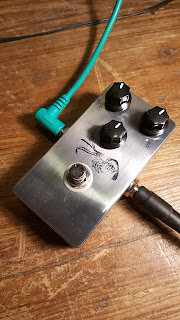Overdrives are going to boil down mostly to a hard clipping 250 style or soft clipping Tube Screamer style op amp overdrives. The op amp boosts the signal. The clipping diodes shave off the top, bottom or both of the sound waves. This is not how a tube works. This does not sound like a tube. It does however distort the signal in a pleasing way. The differences of all the myriad ODs out there are due to passive component choices (e.g., big input capacitor for more low end), the inclusion or not of buffers, etc.
What follows is my own personal emotional response to these two types of op amp overdrives.
 |
| SHRIMP13 DOD 250 Clone |
So simple, an op amp boost with clipping diodes after the IC. It covers a wide territory from slight gain and boost to classic rock distortion tones. It is pretty warm (dull) at the low gain end and bright as you increase the gain. The input cap and op amps changed over the years. The op amp doesn't effect much sonically. Some might be quieter or have slightly different gain. The input cap, however, affects tone a lot. The larger cap allowed for more low end but also kind of farts/fizzes out a bit with low notes. Later versions had a smaller cap that tightened things up at the low end. I personally like that out of control low end for some guitars, single coil Fenders in general and Telecasters in specific. When I plug a Tele into a 250, I am inspired to play 70s riffs and blues solos until I forget what time it is. It has a tasty grit that scratches a certain tonal itch with perfection. With humbuckers I sense no deliciousness, more of a fizziness and harshness. For me, the 250 is THE OD for a Tele, a perfect match.
 |
| SHRIMP13 Tube Screamer Clone |
Tube Screamer
The Tube Screamer moves the clipping section to a loop within the op amp. The result to me is a blunted, boxed in, smoother grit with a lot of the clean lower frequencies coming through. It sounds like your clean signal is riding along with the overdriven signal. I guess this is a good thing for cutting through the mix, similar to the early Russian Muffs which strike me the same way, clean and fuzz separated in the sound. They hit the ears separately. For humbuckers I like an OD with Tube Screamer architecture but without buffers. Simpler is better. The Zen Drive comes to mind as a great humbucker friendly drive. It's bright enough to let some character come through the overdrive. I have had great luck with lower gain settings with PAF or Filtertron type 'buckers. Again, one might find himself sucked into a tonal flavor black hole only to emerge and realize everyone else has gone to bed.
Summary
I like 250s for Fenders and Tube Screamers for humbuckers and Filtertrons.









